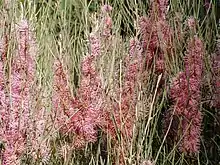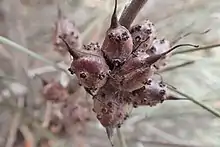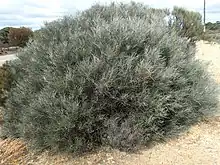| Hakea scoparia | |
|---|---|
 | |
| Scientific classification | |
| Kingdom: | Plantae |
| Clade: | Tracheophytes |
| Clade: | Angiosperms |
| Clade: | Eudicots |
| Order: | Proteales |
| Family: | Proteaceae |
| Genus: | Hakea |
| Species: | H. scoparia |
| Binomial name | |
| Hakea scoparia | |
 | |
| Occurrence data from Australasian Virtual Herbarium | |

Hakea scoparia is a species of flowering plant in the family Proteaceae and is endemic to the south-west of Western Australia where it grows in shrubland. It is a shrub with ascending branches, terete leaves and clusters of cream to pinkish flowers in leaf axils from June to September.
Description
Hakea scoparia is a rounded, many-stemmed shrub with smooth bark, ascending branches, 1–3.5 m (3–10 ft) high and does not form a lignotuber. The inflorescence consists of 50-70 pinkish-cream coloured flowers that appear in clusters in the leaf axils. The pedicels are smooth, the perianth cream coloured ageing to pink or orange-pink and the pistil 13–15 mm (0.51–0.59 in) long. The branchlets are densely covered in short, soft matted hairs or short, soft silky hairs at flowering time. Sometimes sparsely smooth without hairs. The leaves are more or less needle-shaped, 12–27 cm (5–10 in) long and 1.5–2 mm (0.059–0.079 in) in diameter. The leaves grow alternately and have 5 longitudinal veins along their length. Three dimensional rough textured seed capsules are approximately 2 cm (0.8 in) long and 1 cm (0.4 in) wide, ending in a short prominent beak. The fruit grow in groups of 1-8 per axil on a short stalk.[2][3][4][5]
Taxonomy and naming
Hakea scoparia was first formally described in 1845 by the Swiss botanist Carl Meissner in Plantae Preissianae.[6][7] His description was based on plant material collected from the environs of the Swan River by James Drummond.[6] The specific epithet (scoparia) is derived from the Latin word scopa meaning "broom"[8] a reference to the foliage.[3]
Distribution and habitat
Hakea scoparia is a widespread species mainly across the wheatbelt region of Western Australia, from south of Northampton to Dumbleyung and extending in the east to Yilgarn. Grows in heath and scrubland in yellow sand over laterite, gravel, sandy-clay and loam. A frost tolerant ornamental species preferring a sunny aspect.[2][3]
Conservation status
Hakea scoparia is classified as "not threatened" by the Western Australian Government Department of Parks and Wildlife.[2]
References
- ↑ "Hakea scoparia". Australian Plant Census. Retrieved 13 September 2019.
- 1 2 3 "Hakea scoparia". FloraBase. Western Australian Government Department of Biodiversity, Conservation and Attractions.
- 1 2 3 Young, J A. Hakeas of Western Australia:A Field and Identification Guide. J A Young. ISBN 0-9585778-2-X.
- ↑ Holliday, Ivan. Hakeas:A Field and Garden Guide. Reed New Holland. ISBN 1-877069-14-0.
- ↑ Barker, Robyn M.; Haegi, Laurence A.; Barker, William R. (1999). Flora of Australia Volume 17B Proteaceae 3 Hakeas to Dryandra. Australina Biological Resources Study. ISBN 0-643-06454-0.
- 1 2 "Hakea scoparia". APNI. Retrieved 7 November 2018.
- ↑ "Hakea scoparia". Biodiversity Heritage Library. Retrieved 13 September 2019.
- ↑ Brown, Roland W. (1956). The Composition of Scientific Words. Washington D.C: Smithsonian Institution Press. p. 686.
